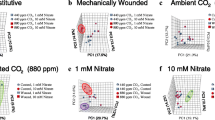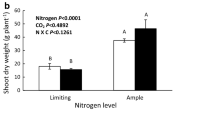Abstract
“Nitrogen surplus” models for nicotine production induced by leaf damage predict that the observed increase in root nicotine synthesis after leaf damage results from “overflow” metabolism; reduced nitrogen existing in excess of growth requirements is shunted into nicotine biosynthesis. To test the nitrogen surplus model for induced nicotine production, we measured the concentrations of the majorN-containing metabolites exported from the roots and the nitrate reductase activity (NRA) of roots and shoots in damaged and undamagedNicotiana sylvestris plants. Leaf damage: (1) had no significant effect on root or shoot NRA, (2) increased nicotine export and decreased amino-acid and amide export from the roots of NO3-fertilized plants, and (3) had no significant effect on the export of anyN-containing metabolite from the roots of NH4-fertilized plants. These results are not consistent with the nitrogen surplus model and indicate that leaf damage has a direct influence on root alkaloid metabolism.
Similar content being viewed by others
References
Andrews, M. 1986. The partitioning of nitrate assimilation between root and shoot of higher plants.Plant, Cell Environ. 9:511–519.
Aryan, A.P., andWallace, W. 1983. Involvement of alcohol dehydrogenase in the enhancement of the in vivo nitrate reductase activity of root tissue by propanol.Plant Sci. Lett. 30:25–32.
Baldwin, I.T. 1988. Damaged-induced alkaloids in tobacco: Pot-bound plants are not inducible.J. Chem. Ecol. 4:1113–1120.
Baldwin, I.T. 1989. The mechanism of damaged-induced alkaloids in wild tobacco.J. Chem. Ecol. 15:1661–1680.
Baldwin, I.T. 1993. Chemical changes rapidly induced by folivory, pp. 1–23,in E.A. Bernays (ed.). Insect-Plant Interactions, Vol. 5. CRC Press, Boca Raton, Florida.
Baldwin, I.T., Sims, C.L., andKean, S.E. 1990. Reproductive consequences associated with inducible alkaloidal responses in wild tobacco.Ecology 71:252–262.
Baldwin, I.T., andOhnmeiss, T.E. 1993. Alkaloidal responses to damage inNicotiana native to North America.J. Chem. Ecol. 19:1141–1151.
Baldwin, I.T.,Karb, M.J., andOhnmeiss, T.E. 1994. Allocation of 15N from nitrate to nicotine: Production and turnover of an induced defense. Submitted.
Boodley, J.W., andSheldrake, R.J. 1977. Cornell peat-lite mixes for commercial plant growing. Cornell Information Bulletin 43.
Bryant, J.P., Chapin, F.S., III, andKlein, D.R. 1983. Carbon/nutrient balance of boreal plants in relation to vertebrate herbivory.Oikos 40:357–368.
Cataldo, P.A., Haroon, M., Schrador, L.E., andYoungs, V.L. 1975. Rapid colorometric determination of nitrate in plant tissues by nitration of salicylic acid.Commun. Soil Sci. Plant Anal. 6:71–80.
Gehrke, C.W., Nakamoto, H., andZumwalt, R.W. 1969. Gas-liquid chromatography of protein amino acid trimethylsilyl derivatives.J. Chromatogr. 45:24–51.
Gershenzon, J. 1984. Changes in the levels of plant secondary metabolites under nutrient and water stress.Recent Adv. Phytochem. 18:273–321.
Haslam, E. 1986. Secondary metabolism-fact and fiction.Nat. Prod. Rep. 1986:217–249.
Jaworski, E.G. 1971. Nitrate reductase assay in intact plant tissues.Biochem. Biophys. Res. Commun. 43:1274–1279.
Johnson, N.D., Liu, B., andBentley, B.L. 1987. The effects of nitrogen fixation, soil nitrate, and defoliation on the growth, alkaloids, and nitrogen levels ofLupinus succulentus (Fabaceae).Oecologia 74:425–431.
Kallarackal, J., Orlich, G., Schobert, C., andKomor, E. 1989. Sucrose transport into the phloem ofRicinus seedlings as measured by the analysis of sieve-tube sap.Planta 177:327–335.
Koch, G.W., Winner, W.E., Nardone, A., andMooney, H.A. 1987. A system for controlling the root and shoot environment for plant growth studies.Environ. Exp. Bot. 27:365–377.
MacKown, C.T., Sutton, T.G., andBush, L.P. 1990. Nitrogen compositional changes in xylem exudate and leaves of burley tobacco.Crop Sci. 30:133–138.
Nowacki, E., Jurzysta, M., Gorski, P., Nowacka, D., andWaller, G.R. 1976. Effect of nitrogen nutrition on alkaloid metabolism in plants.Biochem. Physiol. Pflanzen 169:231–240.
Oaks, A. 1992. A re-evaluation of nitrogen assimilation in roots.BioScience 42:103–111.
Oaks, A., andHirel, B. 1985. Nitrogen metabolism in roots.Annu. Rev. Plant Physiol. 36:345–365.
Rabe, E. 1990. Stress physiology: The functional significance of the accumulation of nitrogen containing compounds.J. Hortic. Sci. 65:231–243.
Reuter, V.G. 1957. Zustandsbedingte Produktinsanderungen spezifischer Stickstoff-verbindungen in der Tabakpflanze.Die Kulturpflanze 5:137–185.
Reuss, R.W. 1988. The interaction of defoliation and nutrient uptake inSporobolus kentrophyllus, a short-grass species from the Serengeti Plains.Oecologia 77:550–556.
Rufty, T.W., Jr., Volk, R.J., McClure, P.R., Israel, D.W., andRaper, C.D., Jr. 1982. Relative content of NO3 and reduced N in xylem exudate as an indicator of root reduction of concurrently absorbed15NO3.Plant Physiol. 69:166–170.
Saunders, J.W., andBush, L.P. 1979. Nicotine biosynthetic enzyme activities inNicotiana tobacum L. Genotypes with different alkaloid levels.Plant Physiol. 64:236–240.
Scholander, P.F., Hammel, H.T., Bradstreet, D.E., andHemmingsen, E.A. 1965. Sap pressure in vascular plants.Science 148:339–346.
Wakhloo, J.L., andStaudt, A. 1988. Development of nitrate reductase activity in expanding leaves ofNicotiana tabacum in relation to the concentration of nitrate and potassium.Plant Physiol. 87:258–263.
Waterman, P.G., andMole, S. 1989. Extrinsic factors influencing production of secondary metabolites in plants, pp. 107–134,in E.A. Bernays (ed.). Insect-Plant Interactions. CRC Press, Boca Raton, Florida.
Author information
Authors and Affiliations
Rights and permissions
About this article
Cite this article
Baldwin, I.T., Oesch, R.C., Merhige, P.M. et al. Damage-induced root nitrogen metabolism inNicotiana sylvestris: Testing C/N predictions for alkaloid production. J Chem Ecol 19, 3029–3043 (1993). https://doi.org/10.1007/BF00980600
Received:
Accepted:
Issue Date:
DOI: https://doi.org/10.1007/BF00980600




